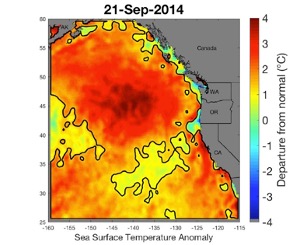Posts by ooistaff
A Data Assimilative Reanalysis at the New England Shelf Pioneer Array
Scientists undertook a four-year retrospective reanalysis of ocean circulation at the Pioneer Coastal Array site. The system captures circulation features that characterize the inhomogeneous, rapidly evolving, and ephemeral submesoscale circulation.
Read MoreShelfbreak Productivity Interdisciplinary Research
The continental shelfbreak of the Mid-Atlantic Bight supports a productive and diverse ecosystem, driven by primary production by phytoplankton. The Coastal Pioneer Array provided unprecedented spatial and temporal resolution of the frontal system, including a four-dimensional context to conduct a detailed study of frontal dynamics and plankton communities.
Read MoreShelf Water Subduction and Cross-Shelf Exchange
In recent years, the Gulf Stream in the Northwest Atlantic has become increasingly unstable and is shedding more warm core rings in the Slope Sea.The Coastal Pioneer Array at the Mid-Atlantic Bight shelf edge identified a form of offshore transport of water for the first time, supporting an ocean model to study the dynamics of the shelf-water offshore transport.
Read MoreForecasting Hypoxia to Support the Dungeness Crab Fishery
Hypoxia is regularly experienced in Washington and Oregon waters and has been linked to mass mortality events of hypoxia-intolerant species, including the valuable Dungeness crab. The Coastal Endurance Array is aiding the development of a hypoxia forecasting system in this region.
Read MoreIdentifying Impacts of Ocean Acidification and Hypoxia
Ocean acidification has emerged as a leading threat to marine ecosystems, and the fisheries and shellfish growers that depend on a productive and vibrant ocean. The Coastal Endurance Array in the Pacific Northwest array is situated in an epicenter for early impacts from the co-occurrence of ocean acidification and hypoxia.
Read MoreDrivers of Ocean Overturning Circulation Revealed
rminger Surface Mooring data were used to identify a new mechanism by which the atmosphere controls ocean heat loss leading to dense water formation. The results are particularly important as the connection between air-sea exchanges and the ocean circulation is still poorly understood, hindering attempts to understand the climate change induced slowdown of the Atlantic circulation.
Read MoreSouthern Ocean Air-Sea Interaction
The Southern Ocean is an important region in the global ocean uptake of heat and carbon. Data collected by OOI’s Global Southern Ocean Surface Mooring helped identify extreme heat loss events driven by cold Antarctic winds in driving the seasonal mixed layer deepening in the region and dramatic year-to-year variations.
Read MoreInternal Tide Impacts on Ocean Circulation
Internal tides (ITs) have critical roles in determining the meridional overturning circulation and oceanic heat budget. The Regional Cabled and Coastal Endurance Arrays data are making it possible to identify the impacts of changes associated with the ITs.
Read MoreMarine Heatwaves
The Coastal Endurance, the Regional Cabled, and the Global Station Papa Arrays were key in identifying and monitoring the approach of a marine heatwave known as the “Blob” and its links to multiple ecosystem impacts on the US west coast.
Read MoreAccelerating Marine Ecological Research
Mid-trophic level organisms, such as zooplankton and forage fish, play a critical role in mediating energy transfer from primary production to top predators in the marine ecosystem. Using Coastal Endurance Array echosounders, scientists are observing long-term changes in the distribution and abundance of this important part of the marine food web.
Read More









